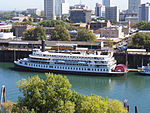Hapgood-Hume Company

Hapgood-Hume Company was a Salmon cannery and now a historical site in West Sacramento, California in Yolo County. The site of the former Hapgood-Hume Company is a California Historical Landmark No. 1040 listed on April 1, 2009. The Hapgood-Hume Company was the First Pacific Coast Salmon Cannery founded on April 1, 1864, on the Sacramento River, closed in 1873 in Washington state. The site of the Hapgood-Hume Company was a National Register of Historic Places, #66000938, from April 6, 1964, to July 14, 2004. The Hapgood-Hume Company was formed by Robert Deniston Hume, William Hume, John Hume, and George Hume, with a friend Andrew Hapgood. All of founders of the company came from Maine. Hapgood had been a tinsmith and a fisherman in Maine, arriving in California in 1864.
Excerpt from the Wikipedia article Hapgood-Hume Company (License: CC BY-SA 3.0, Authors, Images).Hapgood-Hume Company
1st Street,
Geographical coordinates (GPS) Address Nearby Places Show on map
Geographical coordinates (GPS)
| Latitude | Longitude |
|---|---|
| N 38.58312 ° | E -121.50896 ° |
Address
1st Street
1st Street
95814
California, United States
Open on Google Maps










